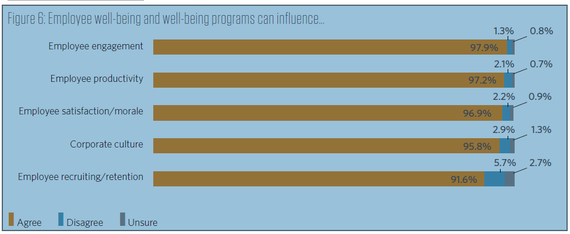Gallop Management Journal publishes a semi-annual Employee Engagement Index (EEI). Their most recent U.S. results show that:
- Little improvement in employee engagement over the past year.
Defined in positive psychology, engagement is a pillar of wellbeing that refers to being absorbed, interested and involved in one's work and is a key measurement for workplaces today.
Very high levels of engagement are known as a state of "flow" in which you are so completely absorbed in an activity that your lose sense of time.
Engaged personnel are enthusiastic about and exhibits a strong desire for excellence. They have a noticeable fascination and commitment to doing a good job. They are also emotionally connected to both their team-members and the company's mission which shows they essentially care about its future.
Does Employee Engagement Really Matter?
According to the Gallop's extensive research, employee engagement is strongly connected to business outcomes essential to an organization's financial success, such as productivity, profitability and customer engagement. Engaged employees support the innovation, growth and revenue that their companies need.
Engagement matters and company leaders should be concerned. Reported in the 2015 Conference Board CEO Study, elevating employee engagement has become one of an organization's highest priorities all around the globe.
Most employers recognize that engaged employees produce more and stay longer in an organization that treats them well, listens to their needs and helps them develop.
And while most organizations measure employee perceptions in some fashion, few have been successful building, sustaining and leveraging employee engagement to create tangible business outcomes.
The challenge has intensified with the emergence of a new generation in the workforce, heightened international competition and the unparalleled pace of change in the world, according to The Engagement Institute.
Boosting Employee Engagement With Employee Wellbeing
Team leaders, executives and employees are busy while facing many employer-employee issues like work stress, poor health and strained personnel relationships. This can lead to disengagement.
What's needed is a simple and stress-free antidote for developing a stronger community across the organization. Given the traditional surveys, assessments and band-aid approaches trying to solve this problem, company leaders are still pursuing alternative solutions.
To address these issues, they must focus on investing in wellbeing programs.
It's time to take wellness from an HR initiative to a true business imperative, according to National Business Group on Health's Institute (NBGH).
It's simple. Unhappy workers have a profound impact on a company's bottom line.
Wellbeing programs can be used unpretentiously in many different ways. Not only will these programs increase workforce engagement, but are included with satisfaction and overall happiness.
It is reported that senior executives and area managers are actually looking beyond traditional programs and toward ones that treat more than just physical health.
As the survey results below shows, wellbeing programs can influence engagement, productivity and moral. Image graphic courtesy Virgin Pulse.
Why Invest in a Wellbeing Program?
Wellbeing infuses every aspect of work and offers programs that address mental focus, physical energy and emotional drive (given that on average half of our waking hours are used at work).
A holistic approach to engaging employees can spiral into a healthier and happier workforce with positive changes like these:
- superior performance, productivity
This shows that engaged employees can undoubtedly impact the quality of their company's product. Companies that do better at holistically engaging their employees will unquestionably outsmart their competition.
A workforce aren't just bodies. Their minds and emotions are part of the total package that makes up an employee. The more organizations recognize and address the total nature of wellbeing, the better they'll be able to keep their employees happy, healthy, engaged and their businesses flourishing.
________________
Dr. Deana speaks on workplace wellbeing and helps organizations improve engagement, culture and morale. She has authored three books including the anthology, Resilience

